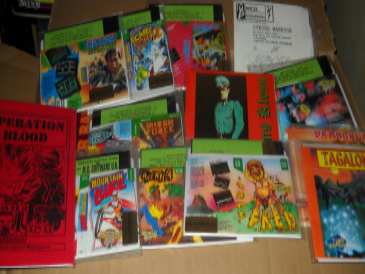
(February 18) Early
homebrew games
Many larger developers like Electronic Arts began to earn their
reputations on the early home computers, but there were also innumerable
smaller publishers that made an impact during the classic era. In Europe,
legions of what would now be known as home-brewers published excellent
titles. Of course, the packaging and some of the production elements
aren't as polished as commerical releases, but there was plenty of heart
in some of these games and they definitely had more freedom than the
bigger commercial vendors, which is still true today if you look at the
smaller games on the App Store and compare them with big-budget releases.
Its interesting to see that the phenomenon was present even at this early
stage in game industry development. Atari itself recongnized this as well,
forming a division called APX, or Atari Program Exchange that allowed
smaller, bedroom programmers to submit games and other titles to be
published - some of these, such as Eastern Front became commercial
releases later on. This selection of games largely consists of European
developers and their always-entertaining titles. Some of these titles make
an appearance in somewhat obscure corners of the classic firmament, but
are worth seeking out. Many of these games are largely unknown by today's
standards, but offered the adventurous player excellent games. Take for
example the arcade-style shooter Operation: Blood, a solid version of
Taito's Operation: Wolf that appeared near the beginning of the 90's on
that Atari home computers. There's plenty of variety to be had as well,
with role-playing games such as Tagalon, side-scrolling platform games
such as Fred, more challenging military titles like Hans Klaus and more.
Other surprisingly good homebrew titles included Cyber Warrior, a
micro-developed title that mixed elements of Metroid and Defender. There
was an abundance of cassette titles, with many appearing later on with
floppy conversions, such as Mirax Force, an excellent shooter in the vein
of Super Cobra or Scramble. It just goes to let you know that it pays to
look a little deeper into the library of a system to discover games you
might enjoy. This is especially true on the early computer plarforms,
where the more open environment attracted many more experimental
developers.
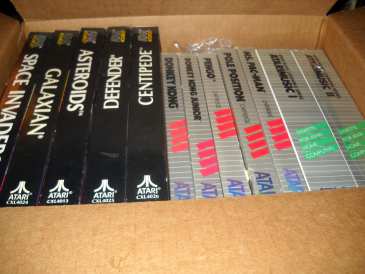 (February
9) Atari classica
(February
9) Atari classica
Here's a core collection of classic titles Atari released for the 8-bit
computers. Most of these should be familiar to veteran players, with the
likes of Space Invaders, Galaxian, Defender, Asteroids, and Centipede
occupying their large classic black boxes in style. The silver box games
are also interesting, in that many of these were re-issued later on in
smaller, and occasionally, even black and white boxes. Fortunately, these
are all original releases, with classics like Pole Position, Pengo, Ms.
Pac Man plus Donkey Kong and Junior. Yes, these came out on the 800 line -
Nintendo must have been smarting, since Atari took the time to do these
conversions right, including all the screens and even the intermission
sequences. These are defining moments for the computer line's arcade
games. This section concludes with a pair of educational titles, Atari
Music I & II which offered basic tutorials on note reading and
composition. It's a mystery why these exciting two titles haven't spent
much time out of their boxes.
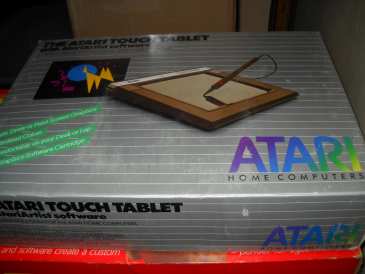 (February
8) Atari Touch Tablet
(February
8) Atari Touch Tablet
When you look back on the history of
home computers back in the early 80's, one of the more interesting aspects
of the era was its emphasis on creativity and user created content. One of
the best examples of this were than many paint programs and devices that
came out during this time. Atari was no exception to this, and they
produced their own excellent peripheral, the Atari Touch Tablet. Similar
in approach to the Koala Pad, Atari's version was definitely more stylish
and slick in approach, with an almost all-black tablet highlighted by
lines of white, definitely fitting with the futuristic XL line aesthetic.
It also had a much better pen, which was hooked up to the tablet via a wie.
This approach gave the end user a much more accurate and comfortable
interface which to use. The included software, AtatiArtist was quite
simple to learn and use, and many of the basics were copied into the other
paint programs of the time. Its definitely one of the better-produced
items from that time, and a signature product from Atari's 8-bit computer
era.
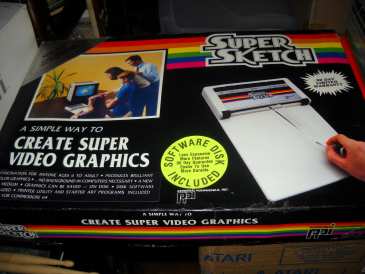 (February
7) Super Sketch
(February
7) Super Sketch
Here's one of the coolest items, in terms of a prototypical computing
device. This is a very rare Super Sketch graphics tablet by Personal
Peripherals for the Atari computers. Unlike the Koala Pad and Atari
tablets, this one features a fixed stylus which is used to trace images on
the screen. Its a bit more limited, but has a very interesting design and
decent construction. The elaborate manual and disk centers on the
potential that you can achieve with the device, though its much harder in
practice than theory. An enclosed workbook contains images that you can
trace. The interface is quite straightforward, but there are some
surprisingly interesting, advanced features such as the ability to zoom
into images and work on them pixel by pixel. Super Sketch is definitely a
product that was ahead of its time, and an interesting precursor to the
Wacom tablets in use today. For its time, its was a sophisticated device
but by today's standards, it's a fairly limited item in terms of
creativity. You can save your images to disk and you can get something
decent if you put the time into it. While not something that will appeal
to all users, the Super Sketch tablet is definitely one of the cooler
items in the Laser's classic gaming collection for the computer
artist.
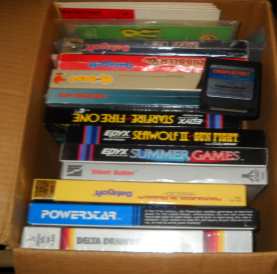 (February
4) The home computer arcade
(February
4) The home computer arcade
This exhibit in our ongoing Atari home computer collection has some
interesting arcade and other style games to go through. One of the things
that's frequently overlooked in the gaming histories you read is that
innovative ideas didn't end with the great crash, and many of the best
developers continued working and breaking new ground on the popular home
computers of the time. You'll notice three Epyx titles first, a company
that held the torch during these dark times. One of which is the classic
Summer Games, a multi-event title that was quite advanced for its time,
presaging the mini-games comps like Wii Sports that came out decades
later. Another highlight in this box, at least from a collector's
standpoint, are the pair of rare Epyx comps that gave players a chance to
play even older games. The first of these included a pair of Bally/Midway
titles in the form of Seawolf II and Gunfight, while the second comprised
of two rare Exidy titles, Star Fire and Fire One, which were basic, yet
enjoyable arcade shooters.
You probably can't make it out, but
there a few other shooters here - Nibbler and Microprose's Air Rescue I.
MicroProse was much better known for its military flight sims, but this
early release was a solid and interesting 2D helicopter shooter where the
objective was to fly through tunnels and avoid shots while rescuing
hostages. Its theme might be similar, but its a very different game than
the classic Choplifter (pictured for reference), requiring more strategy
to complete and beat. There are a few other varied titles, such as the
early and simple paint program Delta Drawing, and the odd role playing
game PowerStar. This was strange, since not only was it on cartridge, it
also added a few space shooting scenes. Finally, we have an early copy of
Jawbreaker, complete in its original ziplock-style bag. This type of
packaging was used in early 80's computer games, and while not as
sophisticated as the games of today have, is an excellent reminder of the
DIY roots that infused this pioneering era of computer gaming.
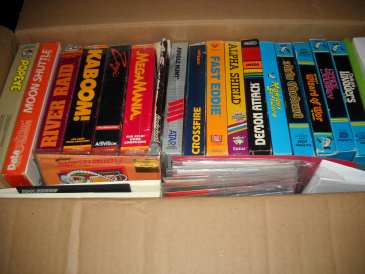 (February
3) Obscurities & Old Favorites
(February
3) Obscurities & Old Favorites
Here's another selection of classic Atari computer software. This lot
has some really good solid arcade titles with the selection of Rocklan
boxed titles an especially cool part of the collection. Wizard of Wor is
probably one of the finest conversions that appeared on the console, and
the other titles such as Gorf and Deluxe Invaders are consistently
excellent. Rocklan also released many non-arcade games with Diamond Mine,
Space Journey and Journey to the Planets (not pictured here) standing out
from the pack. Several more obscure titles like Siruis' Alpha Shield (a
slightly simpler version of Reactor) and Fast Eddie (a fairly decent
jumping game) are also included in this small section. Obviously, any
Atari collection would not be complete without a few excellent Activision
titles. There are a couple of fine boxed examples here like Kaboom,
Megamania, River Raid and Zenji, plus boxed Popeye thrown in for good
measure. These are fun to play, but they aren't substantially different
from the other console ports.
One of the prizes in the collection for
an arcade game collector is the hard to come by Moon Shuttle, Datasoft's
conversion of the obscure Nichubistu coin-op. It's a very cool space
shooter that features multiple screens and some very challenging gameply.
There were a number of very good arcade games that never came out on
console, but were released on the home computers that rose to fill the
void between game booms. Another one in this mold is Juno First, another
solid conversion. Another great one you don't hear that much about these
days is Broderbund's classic AE, which had a precursor to today's games,
complete with pre-rendered backgrounds. Unfortunately, the box for this is
a bit crushed, but it's nice to have an example in the Laser's
archive.
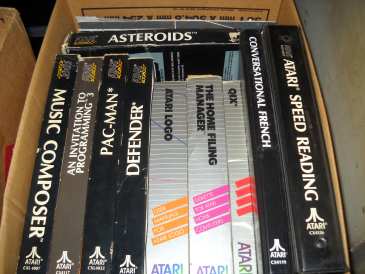 (February
2) Atari School
(February
2) Atari School
Here's today's excerpt from our collection, an excellent assortment of
Atari's own branded games. There are some true classics here like
Asteroids, Qix, Pac Man and Defender. A few other misc. titles are
included - with the weird tape titles Speed Reading and Conversational
French thrown into the box. Music Composer is a fairly decent early
educational title while 'An Introduction to Programming" offers what
you'd expect: a simple course in the BASIC language spanning several
tapes. Atari produced three volumes in this series altogether. All of
these titles are boxed and complete with their original instructions.
There are some interesting games here but not everything in our archives
is that exciting.
(February 1) Return to Avon Hill
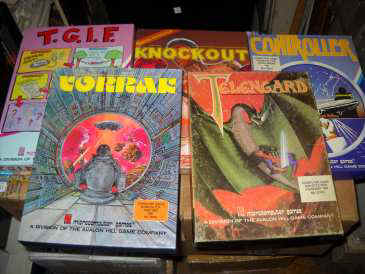 Here's
a fairly interesting lot of Avon Hill/Microcomputer Games for the Atari
8-bit home computers. These were mostly purchased still new and playing
them now shows that there was a lot of sophistication in the games back
then. Telengard was a forward-looking role-playing game that was quite
difficult and featured randomized dungeons, multi-level design, though it
had somewhat tame visuals. One of the odder things I tried was Controller,
which was actually a weird idea about becoming an air-traffic controller.
This was a complicated game and one that I needed to look at the manual
continually in order to figure out. Its visuals weren't that interesting,
but it was a cool idea, limited by the hardware of the time.
Here's
a fairly interesting lot of Avon Hill/Microcomputer Games for the Atari
8-bit home computers. These were mostly purchased still new and playing
them now shows that there was a lot of sophistication in the games back
then. Telengard was a forward-looking role-playing game that was quite
difficult and featured randomized dungeons, multi-level design, though it
had somewhat tame visuals. One of the odder things I tried was Controller,
which was actually a weird idea about becoming an air-traffic controller.
This was a complicated game and one that I needed to look at the manual
continually in order to figure out. Its visuals weren't that interesting,
but it was a cool idea, limited by the hardware of the time.
One of the the strangest games in this sub-collection is T.G.I.F., a
simplistic video board game in the mold of the famous "Game of
Life" where you had a random series of events that occurred on
different days. Some of them were lame, but there were some funs ones like
the Lottery and Treasure hunt. This interesting selection of mini-games
made this an interesting title that was ahead of its time, though
obviously it was more fun with multiple players. The most interesting find
of the lot has to be Vorrak, a cool space-shooter in the mold of Scramble,
that gave you the added challenge of having a single short beam that only
reached a short distance from your ship. Its levels were challenging and
sophisticated, definitely one of the better 8-bit shooters we've seen and
something that we're glad to rescue from obscurity.
Unfortunately, the Knock-Out boxing game
has gone unplayed because our vintage Atari 810 tape drive apparently no
longer works. Not to worry, we'll have this situation solved soon. What
makes the Avon Hill titles so interesting is their large boxes with unbelievably
good artwork, the cover of Vorrak wouldn't feel out of place on a Science
Fiction magazine. This visual approach was matched by AH's sophisticated, decidedly
adult designs that didn't condescend to their audience. They seem a little
more sober in their presentation than most of the other games available at
the time, which makes them stand out from the pack. Looking around online,
its surprising how prolific AH was back in those days and how many titles
that they were able to release in such a short period of time and their consistent
quality gives AH a special place in many classic gamers' hearts to this
day.
(January
31) Uncaged
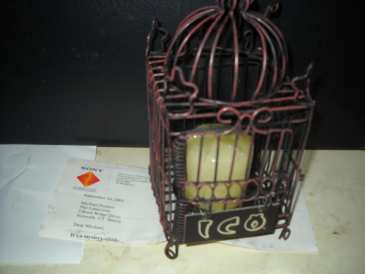 In
case you were wondering what the mysterious cage behind the rare 5200
controller was all weekend. You probably had an idea if you were into odd,
strange and beautiful cult-favorite PS2 games. Yes, indeed, this is one of
the coolest pieces of swag we've gotten at the Laser over the years. It is this cool
Playstation 2 Ico press kit bonus item. This was an exclusive piece given to the press,
and it came with a metal cage complete with candle, which makes it a truly
inspiring piece of gaming artistry in itself.
In
case you were wondering what the mysterious cage behind the rare 5200
controller was all weekend. You probably had an idea if you were into odd,
strange and beautiful cult-favorite PS2 games. Yes, indeed, this is one of
the coolest pieces of swag we've gotten at the Laser over the years. It is this cool
Playstation 2 Ico press kit bonus item. This was an exclusive piece given to the press,
and it came with a metal cage complete with candle, which makes it a truly
inspiring piece of gaming artistry in itself.
It's a very nicely designed piece that immediately brings to mind
the game's cool opening sequence and Ico's unique art-style. I also have the original printed
press kit buried somewhere, which I might be persuaded to search for.
There are loads of press kits for good games in my collection, though an
equal number of duds as well - just like the games. It's neat that the
attached note also includes the original release date, since precise dates
for landmark games usually end up lost to time. I'd like to take this opportunity to remind everyone
that the items in the collecting 'voice modules' aren't for sale,
these are articles that explore the history of games through their various
artifacts. I need to make this clear since I know someone will ask.
Several people have also asked if we'll be linking to specific items for
sale on auction sites. Our answer is a firm 'no.' There's one
set of standards when it comes to unearthing something cool from the
Laser's collection as a way of explaining its significance in gaming
history. Photographing and displaying it for our readers to see is one
thing, but using the site to hype an auction, even one we don't directly
own or control, would be highly unethical.
(January 30) Atari XE Game System - The
Software
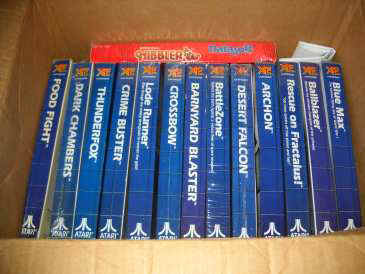
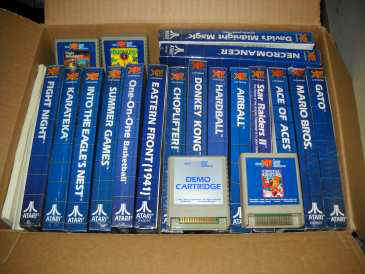
Here's the Laser's nearly complete collection of XE Game System
titles, known as the blue box releases. These were issued to compliment
the XEGS. The games were mostly revivals of earlier games, but
surprisingly a few new games such as Crime Busters, ThunderFox,
Crystal Castles and Mario Bros were released. Older games also underwent significant
revisions, and these are not surprisingly highly sought after.
Later releases like Into the Eagle's Nest, Choplifter and, Summer Games
were given cosmetic upgrades while some of the earlier games like Blue
Max, One on
One and Necromancer were released on cartridges for the first time. There
were a few unreleased titles that were given new life such as Crystal
Castles, Food Fight and Airball that came out for the XE. These
conversions were quite solid. The XEGS is definitely a fun
system for 8-bit collectors and its surprisingly small library of branded
games was joined by other re-issues, offering collectors new avenues to
play these classic games on the long-running Atari Home Computers line. At
that point, the hardware was nearly a decade old, but some of the games
remain quite impressive considering the 8-bit hardware's
constraints.
(January 29) Atari
XE Game System - The lost console
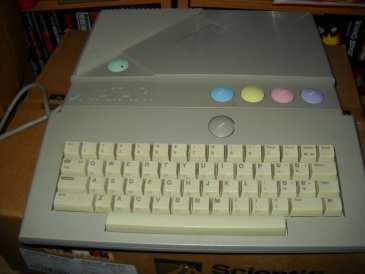 One of the odder moments in video game
history was Atari's interesting attempt to compete with Nintendo via the
XE Game System. Instead of going directly head-to-head as a true gaming
machine, the XEGS was brought to market as a hybrid game machine and
computer. This was basically a repacking of the home computer line
in console form - something that had been tried with limited success in
the 5200 several years earlier. It came packaged with a detachable
keyboard, light gun and a joystick plus two pack-in cartridges and a built
in game, for a total of three games included. This was a good bargain at
the time and the XEGS was a fairly robust system if you wanted a
basic computer and with low-priced entree onto the 8-bit line.
One of the odder moments in video game
history was Atari's interesting attempt to compete with Nintendo via the
XE Game System. Instead of going directly head-to-head as a true gaming
machine, the XEGS was brought to market as a hybrid game machine and
computer. This was basically a repacking of the home computer line
in console form - something that had been tried with limited success in
the 5200 several years earlier. It came packaged with a detachable
keyboard, light gun and a joystick plus two pack-in cartridges and a built
in game, for a total of three games included. This was a good bargain at
the time and the XEGS was a fairly robust system if you wanted a
basic computer and with low-priced entree onto the 8-bit line.
The biggest plus was that it was nearly completely compatible with the XE
line, with specs that matched the 65XE and the older 800XL machines. This
made it possible to hook up a disk drive and play a huge library of disk
games, and use it for other computing purposes. It was an awkward system with pastel buttons and
odd-angled design. It definitely didn't feel as sleek as its SMS and NES
competition, but it was a cool machine if you were a fan of the classic
Atari computer line. I finally got around to adding one of these to my
collection a few weeks ago, and while it couldn't compete against its
contemporaries, the XEGS was aimed at a more educational market than the
pure consoles. It's actually a very nice machine and the keyboard is a
great idea. There was definitely a style and approach that was unique
to the era of Atari and it fits right in with the ST-line styling and
colors of Atari's late 80's era. Its definitely a case of an
interesting idea that looks better in retrospect than it did at the
time.
(January 28) Atari 1200XL - The Revival
Begins
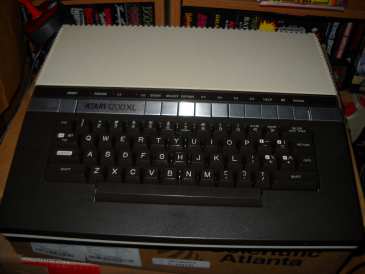 Here's an interesting find I made a few weeks ago, a complete and working
Atari 1200XL computer. This was one of the odder models of the Atari home
computers range. Released in 1982, the system offered several upgrades to
the original 400/800 line with some cool features like a built-in
diagnostic tool and an upgraded OS. Adding to its professionalism were the
function keys, which were cool additions for word processing or other
database functions. There was also a second indicator light on the machine
that displayed memory data. Neither these extra LED lights nor the
function keys appeared on any other Atari 8-bit computer, which further
enhances the 1200XL's unique place in Atari history. Unfortunately, its different OS also
meant it was incompatible with some earlier software. Its closed design
meant it was very difficult to upgrade. All of this led the computer to
have a short lifespan, and thus made it one of the more collectible of the
line. These are difficult to find in working condition, but I found one at
a decent price about a month ago. You can see the appeal immediately, with
its space-age sleek design marking a huge change from the beige 400 and
800 lines. While the 1200XL didn't last long, it styling influenced the
5200 console and was later revised slightly for the later 600XL and 800XL
computers.
Here's an interesting find I made a few weeks ago, a complete and working
Atari 1200XL computer. This was one of the odder models of the Atari home
computers range. Released in 1982, the system offered several upgrades to
the original 400/800 line with some cool features like a built-in
diagnostic tool and an upgraded OS. Adding to its professionalism were the
function keys, which were cool additions for word processing or other
database functions. There was also a second indicator light on the machine
that displayed memory data. Neither these extra LED lights nor the
function keys appeared on any other Atari 8-bit computer, which further
enhances the 1200XL's unique place in Atari history. Unfortunately, its different OS also
meant it was incompatible with some earlier software. Its closed design
meant it was very difficult to upgrade. All of this led the computer to
have a short lifespan, and thus made it one of the more collectible of the
line. These are difficult to find in working condition, but I found one at
a decent price about a month ago. You can see the appeal immediately, with
its space-age sleek design marking a huge change from the beige 400 and
800 lines. While the 1200XL didn't last long, it styling influenced the
5200 console and was later revised slightly for the later 600XL and 800XL
computers.
Unfortunately, the keyboard in the system we purchased was a little
erratic, so we purchased and installed a replacement from Best
Electronics. This was done surprisingly quickly and the system now works like a charm.
You have to love the elegant design of the machine and it's keyboard is very comfortable. It's been one
of those items we've needed for awhile and I'm happy we didn't have to
spend a fortune to add this rare piece of Atari history to the archives.
The Atari 1200XL was a beautifully designed machine and this example is definitely one of the more unique
and interesting items in the Laser's possession.
(January 27) Atari 5200 Competition Pro
Joystick
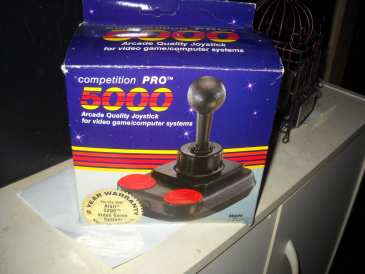 I
was almost finished collecting for the 5200, but there was another
item I needed, and here it is - the elusive 'Competition Pro 5000'
joystick controller for the 5200. Released by an obscure company called
Coin Controls, Inc. the controller was similar to the versions
released famously on the C64, but the Atari 5200 version is quite hard to
come by. It plugs directly into the console without an adaptor and its
sturdy digital stick was more traditional and, this is quite important for
5200 owners, self-centering.
I
was almost finished collecting for the 5200, but there was another
item I needed, and here it is - the elusive 'Competition Pro 5000'
joystick controller for the 5200. Released by an obscure company called
Coin Controls, Inc. the controller was similar to the versions
released famously on the C64, but the Atari 5200 version is quite hard to
come by. It plugs directly into the console without an adaptor and its
sturdy digital stick was more traditional and, this is quite important for
5200 owners, self-centering.
The CP 5000 is a successful addition to the analog
controllers and fit comfortably in your hand. Two included buttons means
you can play games like Countermeasure easily. Unfortunately, the
controller lacks the
keypad, and its start and pause buttons, which means you still need a working 5200
controller to start your games. Still, this represents a nice cherry on
top of my collection - complete in its original box, no less. It also
makes games like Kangaroo, Ms. Pac Man, and Bounty Bob Strikes Back much
easier to play on the console. So, what is that weird thing sitting behind
it? Some kind of cage? I'll let you know in a few days. What do you think
it could be? Meanwhile, I'll be blogging my recent finds here, so let me
know what you think.
(December 1) When
the past runs out of time
Looking back on all the things that
seemed to have happened randomly at the time, it's actually been a very
interesting year that seems to have built up under the surface. From a
technical standpoint, it seems irrational that I've purchased more games
for the Atari 5200 than the Wii, more titles for the Colecovision than
Xbox 360 and almost as many for the Intellivison as PS3. After several
years of lying dormant, the collecting bug struck me again in a bad way
this year. Recently, fate has intervened unexpectedly, and two recent,
seemingly unrelated purchases have triggered strangely resonant events and
led me to make some conclusions about how some things that seem
insignificant can become much more important with time.
It began innocuously enough last January with a quick dalliance with
Dreamcast shmup imports led on by a series of articles I was writing on
the Saturn's import shmup library, which you can find elsewhere on the
site. One thing led to another and I was back again trolling ebay and
other auction sites like gamegavel looking for additional 'pieces' to add
to my somewhat large library of games and systems. Looking over it all,
I'm quite surprised by how large my collection has grown. I started in
earnest nearly 20 years ago after finding a Colecovision at a local thrift
and have been collecting with varying degrees of intensity ever since. My
passion for collecting classic games also coincided with the launch of my
fanzine around the same time, so the two have always had a connection in
my mind. Over the years, there have been some very cool finds and I've
also made some big mistakes along the way. My hobby has gone through ups
and downs but, my passion for collecting has never gone away completely.
There was an extended period from around 1999-2005 when I was focused on
my writing 'career' where I hardy ventured into a thrift store or bought
an oldie online but things changed and I returned to my hobby within a
hobby. There were other years where my collecting was actually much more
important to me than new games. I spent countless hours traversing flea
markets and tag sales looking for anything I didn't have. Much time was
spent cataloging and preserving old magazines, books and guides. It was a
very happy time, a kind of reunion with my youth. At the same time, I was
inspired to begin writing about games and became obsessed with them from
an intellectual standpoint. I spent almost as much time writing about
games as I did playing them.
The mid-90's was when this part of my
collector's life peaked, which was a strange time looking back on things.
It was new era - CD-Rom gaming was coming and the Playstation was just
beginning its revolution and I was still playing Mr. Do's Castle. Not that
it mattered as much back then. The Laser in its fanzine form back in the
early 90's, was a much more eclectic publication than it was now. There
was a lot more 'humor' and I took pride in covering all sorts of games,
not just the big new releases. This was what made it feel less predictable
and more down to earth. As things moved along and I grew older, I began to
focus more on the newer games when I launched the website ten years ago.
The stakes were a bit higher as I moved from doing it as a part-time hobby
to a career - I couldn't waste as much time on the sillier things than I
did in the past. As I grew older, I also took a more in-depth and
analytical tone with writing, which was perfectly keyed towards the more
sophisticated, adult titles that began to arrive in the wake of Grand
Theft Auto III. While I'd write the occasional article about classic
games, I found out through trial and error that the audience that wants to
read about Yars' Revenge isn't the same one that's interested in
Assassin's Creed. I think one of the things that's been missing from the
Laser over the past few years has been that sense of spontaneity and
interesting other pieces, though I can rearrange this. Still, it feels a
little predictable sometimes. Under the professional surface I've created
here on the Laser, my love for the classic games of my youth never
wavered, it just went on the back burner while I put on my journalist hat.
Thinking about how things have gone this
year, what seemed like a chaotic retreat in the first few months gradually
became a kind of clean-up mission. This would be the year to fill in those
last few holes in my collection, to get those final holy grails I needed.
Initially, I focused on the Colecovision and purchased many of the rarer
games like Sector Alpha, Wizard of Id's Math Fun and finally procured the
elusive Tank Wars after many months of trying. Other rares followed on the
2600 with a happy day where Rescue Terra I, a silver label (original)
label Gravitar and Glib came on the same time and a few others. I bulked
up a little on my long-neglected Atari computer collection with the
elusive Atari Touch Tablet coming in boxed form for a surprisingly low
amount of money. Finally, I moved on to the 'big one', my favorite system
of all the classics, Atari 5200. I already had a multi-cart with all the
games, but this wasn't satisfying from a collector's point of view. While
it didn't matter whether I only had the carts on other platforms, for the
5200, I wanted all the original games in their original boxes - something
that would be a decent task but also attainable. I got a few of the easy
ones out of the way early on, with River Raid and Space Shuttle arriving a
few months back. Tougher ones like Death Star Battle and Mr. Do's Castle
took longer to find in decent shape but I was also able to find two of the
hardest ones - Zaxxon and Meteorites in boxed form complete with their
original instructions. This was no easy task, but I managed to do it. Then
after nearly a year of trying to complete the collection, there was only
one game left, a single title that came between me and a complete
collection. It was the hardest one to grab and by far the most expensive
5200 game.
The game was of course Bounty Bob
Strikes Back, the obscure, under-rated sequel to classic platformer Miner
2049er released in 1983 for many consoles. Bounty Bob Strikes Back was
only released in very limited quantities back in 1985 and the 5200 version
is especially hard to find because it was released after the 'Great Crash'
when most retailers had abandoned video games and the 5200 itself had even
been discontinued by Atari. Copies of the game don't come up often on
auction sites and when one popped up for the 5200 a few weeks ago, I
immediately jumped on it without really thinking about it. There was only
the cart, but that didn't matter to me - a boxed copy would probably be so
expensive as to be out of reach for me financially. In this case, the cart
was enough of a prize for me in itself. Not to be overly dramatic, but
this was an exciting moment - I had heard about the game for years and was
finally going to play it on the actual hardware. It was an important thing
to me personally, as Bounty Bob represented the completion of a collection
that I had been working towards, on and off, for many years. It wasn't
that this was rare or valuable, but that it was the last official game on
my favorite classic console.
For all the years of waiting, Bounty Bob
Strike Back's arrival was relatively uneventful. It came without much
fanfare as it came in an anonymous Priority Mail box dropped on my front
porch indifferently by a mail carrier unaware of the magic within. I
looked at the game, held it in my hands and popped it into my 5200. Its
actually a pretty good game and plays nicely, though I don't want to give
too much away Bounty Bob plays like a more elaborate version of Miner
2049er, at least so far. There it was, the crowning achievement of my
collecting career, representing for me, the end game of a long held hobby.
Of course, using 'the end' only means the collecting part - the playing
part will go on for many years. Still, it's hard not to be a little bit
sad that this phase of collecting has come to an end.
Sure, there are several 'homebrew'
titles in development, but these don't carry the same weight or emotion as
the original games do, even those that are remakes of original 1980's era
games. To give you an example, I bought a copy of the homebrew Juno First
for the 2600 and while it was nicely polished and well done, it wasn't the
same as opening and playing a long-sought title like Rescue Terra I for
the first time. It goes without saying that I'll be the first in line for
the reprogrammed version of the Tempest that's supposed to come out
sometime soon for the 5200, but I've already played the prototype, so it
will feel more like an asterisk. Its something that's cool but not 100%
authentic. It might seem like splitting hairs to someone who wasn't there,
but nostalgia is a tricky, irrational thing sometimes. If you're not
really into collecting, you might want to think of it as listening to a
remixed, HQ quality CD of old songs versus finding the original vinyl in
pristine condition at a thrift store. Some people may not care about the
differences, but to the emotional collector, these differences in form
definitely matter.
After the ebullient moment of having
this elusive title in my possession passed, there was a strange feeling
that seemed to take over. I don't know what phrase to use, possibly a form
of post-coital ennui, that accurately describes this emotion. You've
probably felt it, too when you complete a long-standing goal and wonder
what direction you're going to go in next. This lasted a few days and I
decided a trip down south would probably be a perfect solution to this
problem. I gathered a few extra games up and some largely unwanted old
Japanese magazines and decided to go to the famous Digital Press game
store in New Jersey. As the year was coming to a close, I felt a little
bit of a celebration was in order. The fact that the Saturday I was
planning on going was the store's fifth anniversary and coincided with the
monthly Nava meeting of area classic game collectors would probably be a
good thing. If you've never been to the Digital Press store and are only
familiar with the usual chain stores, you're in for a pleasant surprise.
The left side is devoted to the classic games you remember, everything
from NES to Genesis plus a case of rare games in the glass case. The right
side of DP has the more recent stuff like Xbox 360 and PS3. There's a few
arcade machines up front and a LAN section in the back, which gives the
store an eclectic feel where you can find games and systems from virtually
any era of gaming - and at decent prices.
I went back and forth few days before
deciding to actually go, and the drive down was relatively uneventful.
This was surprising considering that it was the weekend after Thanksgiving
and you'd expect the traffic to be a nightmare. It took the usual hour or
so to drive down there and it was a decent crowd. The store itself is a
completely awesome place filled with thousands of classic and current
video games. It helps that it's run by the legendary Joe Santulli along
with his gang of friends like John Hardie and the always helpful Daria,
who make the store one of the coolest destinations I've ever been to.
Since they're not just surviving but thriving during the worst economic
period in 80 years, it says something about how cool they are down there.
You won't meet a nicer, more helpful bunch. Of course, I knew going in
that finding something to top the arrival of Bounty Bob Strikes Back would
be a difficult task, and it nearly happened.
One of my few regrets in my many trips
to New Jersey was selling off my Japanese Sega Saturn system. This
catastrophe occurred over the summer. Periodically, I make the mistake of
trying to rationalize and weigh the cost-benefits of my game collections.
I had a particularly odd moment when I thought it would be a good idea to
sell the item off - There was already a perfectly working American Saturn
in my collection with all the necessary adaptors and discs needed to play
the majority of imports. Trading it in to the DP store seemed like a good
deal - it was something that I rarely used - and I had already burned out
on much of it off playing through tons of Saturn imports earlier in the
year. I figured I didn't need it. It felt bloated, irrational, not needed.
I loaded the impractical hardware into my vehicle and gave it to Joe.
Later, I discovered there were a couple of games that wouldn't work on the
Saturn, even with adaptors. It turned out to be one of the dumbest things
I've ever done. I thought the system would be long gone before I'd get the
chance to return to New Jersey.
It was a near-miss that almost didn't
happen. When I arrived last weekend, I had placed two of my very own trade
boxes on the floor and didn't think to look what was sitting there almost
directly behind them. It was only when I moved them that I saw that,
indeed, there was a Japanese Saturn, just like the one I had traded in. It
was almost as if fate had intervened - some kind of fate drawing me back
to it. When I noticed it after removing my boxes, I immediately did the
rational thing and repurchased probably the same system I had stupidly
traded in a few months earlier. The meeting went off without a hitch and
was crowded as usual. In another stroke of odd coincidence and strangely
compatible wave-lengths, the museum section in the back of the store had
the usual array of odd Japanese systems and games but also a selection of
the original Digital Press fanzines and Collector's Guides - very strange
since I've also been thinking a lot of what inspired my writing originally
and the many friends and fans I met during that time. Joe Santulli and his
friends like Sean Kelly, Kevin Oleniacz, were of course one of the most
important 'fan-eds' to me - he's been a huge inspiration in both my
writing and collecting, over the years. Having the Digital Press store
down there to 'get away' to has been great as well, since the past few
years have been difficult, losing my best friend who also I met through
fanzines. It's strange and irrational how fate seems to work sometimes.
I arrived early and left a little sooner
than I had anticipated - large crowds make me nervous and have been known
to lead to panic attacks on my part, but I still had an enjoyable time in
the store for as long as I could bear it. About ten minutes before I left,
I saw a younger collector excitedly going through the Genesis games and
checking off titles on his list of wanted titles. I knew the feeling
exactly - there's nothing better for a collector than finding something
you've been wanting for a long time. I thought about my recent good
fortune, how the end of the road on one chapter can mean the beginning of
a new one. I felt that I had accomplished several long-standing goals, and
that collecting, at least in the active sense that I had been pursuing it
over the past few years had run its course. I don't I'll completely run
away from it collecting, but I think it might be difficult for me to have
the same passion for the Genesis that I had for the Atari 5200 and
Colecovision era. I think it might be time to pass the torch. I've gotten
most of what I wanted to get and it's probably a good time to stop chasing
the past. I some aspects, I think what I started to do has reached full
circle. I've done this for a long time and after so many years, it seems
like my collecting trip has reached its destination. There are memories
and times I won't soon forget, but it might be time to finally finish this
chapter and start writing the next one.
(February 3) ExciteBike
Reborn
One of the less talked-about things
about the Wii has been the emergence of the virtual console and Wiiware as
a treasure trove for classic gamers. Last year saw some very impressive
releases including Konami's Contra and Gradius remakes, and Capcom's new
Mega Man 9, all of which retraced the series back to their 8-bit roots.
However, one of the more impressive remakes on the console was probably
ExciteBike: World Tour, a complete remake of the original NES game that
did the series proud. Coming from the same developers that make spin-offs
ExciteTruck and ExciteBots, (two of the most under-rated Wii titles),
World Tour stays quite faithful to the original. It has the same side-view
presentation as the original, similar course layouts and most of the same
mechanics. As in the first game, players have the choice of running at
slow or fast speed and can change these at will. The faster speed
increases your velocity but you have to watch out for your engine
overheating. You can perform stunts and jumps just as in the original, but
in a motion control twist, you have to shake your controller when the
vehicle overheats or face a demerit while you wait at the side of the
track. As in the classic NES ExciteBike, you battle not only the on-screen
racers, but the clock as well. There's a time limit for each track and you
have to make it to the top three in order to advance. After each race,
your time is noted and you earn a grade based on your performance. The
game has approximately 12 new tracks and each is set in a variety of
locations, making for some nice scenery along the way. The visuals aren't
terribly elaborate, but this allows you to focus on its simple,
straightforward fun.
There's a slightly more advanced
progression system in the new version, each level consists of four stages
and you have to earn at least a B grade to unlock the next series. The
first two stages are relatively easy, but the later ones prove more
difficult. One of the more impressive aspects of the new game is the
ability to create and share tracks online with other players, which is
very cool. Many of the familiar ExciteBike obstacles like ramps and hills
are present, and the new game plays very much like the original title did.
The retro feel of the game's controls and presentation were very much
appreciated. The appeal of the original game's simplicity definitely
weren't lost on the developers. It was nice to be back into the old series
again and even the familiar themes remained, which is a cool throwback to
the NES days. While it's relatively superficial gameplay mechanics and
simple presentation might be off-putting to players used to more elaborate
titles, we think ExciteBike: World Tour is one of the more enjoyable
titles released on WiiWare to date. It's retro-NES feel makes it the
perfect compliment to the enormously popular New Super Mario Bros Wii and
at only ten dollars, makes ExciteBike World Tour a great addition to your
Wiiware downloads.
(February 2) Game
over for PSP?
It's easy to get sucked into the monthly
sales figures, jump to radical conclusions and make sweeping statements
that aren't true based on closer inspection. Take for example the PSP. If
you look at the sales figures for the last few months in isolation, things
look bleak for Sony's handheld. However, a closer look proves there's more
than a little bit of life left in the system. It might be tempting to sell
it and wait for the next thing to come along. However, the more cynical
observers should realize this is a five year old console, and that second
place doesn't always mean something is a failure. The standard systems are
very solid in our experience and while sales of the PSP Go download-only
mini system haven't exactly taken off its still an interesting experiment.
The PSP Go will probably be remembered as a landmark, as the first
completely online console, not the last of its kind. Nintendo gets all the
credit, but this is an innovative approach in the gaming space which has
relied almost exclusively on packaged physical games for more than 20
years. However, because of a slow initial start and the mindless need to
bash the currently 'out' company, Sony's PSP doesn't get nearly the credit
it deserves or the buzz generated by the rival DS. However, if you take
into account the console's very good sales in Japan, things look a lot
brighter for the system. It's definitely doing good in the East, and while
it may be neglected here, the good news is that the console has plenty of
excellent games available for it that you might not have played yet or are
on the way.
In our opinion, the main reason why you
shouldn't sell your PSP yet is the coming release of Metal Gear Solid:
Peace Walker. Developed by Hideo Kojima himself, the game promises to
deliver the high quality experience that players have come to expect from
the series. While it's not exactly going to be the killer-app that saves
the console, it's definitely something worth considering. Other recent
high profile releases show a high degree of polish and execution. Jak
& Daxter: The Lost Frontier was a title that came out late last year
and received very little attention, but delivered the solid gameplay
mechanics and excellent gameplay you've come to expect from the series.
Rockstar Games also released Grand Theft Auto: Chinatown Wars, an enhanced
version of the DS title that once again wowed gamers who played it.
Namco's Tekken 6 also made a recent and highly regarded appearance on the
PSP, as did Motorstorm, Gran Turismo to name a few. That's plenty of high
profile support right there and many fine reasons why you shouldn't give
up on the system yet. There's also an extensive list of niche titles
coming out including handheld versions of Metal Slug and BlazBlue, so
that's a lot to look forward to. After you get beyond numbers that only
matter to corporate accountants and stop relying on the superficial
judgments of others, a different picture emerges. Once you actually play
the games that have been coming out, you'll find many solidly satisfying
releases and a decent value proposition that has plenty of life left in it
yet.
(February
1) A Novel Approach
Instead of our usual longer pieces, here’s some notes and comments on
recent news in the gaming world. Sony has revealed plans to launch a PSN
exclusive reality show called ‘the Tester.’ If the accusations against
other reality shows are to be believed, maybe they should call it a
‘virtual reality’ show. Many people are wondering about what’s going
on with Sony’s motion controller, and reports indicate the delayed
device might have as many as ten games when it launches. We personally
can’t wait, but we’re hoping the line-up is more imaginative than the
usual mini-games the usually plague motion control game consoles.
Speaking of motion control, we’ve seen a couple of these lame Wii
knock-offs at drug stores and a quick play test of them shows they’re
probably not worth the money. In fact, these ‘entertainment’ consoles
are something that you wouldn’t wish on your worst enemy. Sadly, it
looks like Sega is lending their name to one of these rip-off devices from
Zone, apparently in an attempt to dislodge the 32X as the worst
Sega-branded console in history. Its embarrassing to see how far the
once-proud company has fallen since the last Dreamcast game released
nearly a decade ago. This should be a lesson for other companies out
there, especially the current leaders - you never know when your reign at
the top will end.
(January 29) Magazine
Scene
One of the things that really hasn't changed with me over these many years
is my love for print magazines. It doesn't make logical sense for me to
spend so much money importing old issues from Japan when most of the
information is contained online. On the other hand, I'm probably still a
pack-rat, which dates back to when I was young. I still have virtually
every issue of every magazine I've ever bought. Most people throw these
old books out when they get too old or take up too much space, but I never
really did. I think a lot of this has to do with the fact that I lost a
ton of old issues of Electronic Games in a flood when I was a kid and
never wanted to have that happen to me again.
The thing these days, is that I'm actually a lot
pickier about the books I buy these days than I was in the past.
Fortunately, there aren't as many currently published books these days
which makes my task easier. So what, exactly do I read these days? I've
already spoken of my love for Japan's Arcadia magazine, and my
appreciation of the new direction Gamepro is going in. Aside from that,
there's the Official PlayStation Magazine (US) that offers a surprising
good read. Import issues of Edge and GamesTM are always a pleasure, even
though they're dated by the time they come out here. So that makes 5 mags
I buy regularly. The new EGM sounds great but I'm not going to jump for
joy until I've actually read an issue. It's pretty strange to consider how
many magazines I have. I added it up the other day, and broke 1,000 before
I was halfway through a fairly cursory inventory. This made me deeply
depressed, so I had to stop. The other statistic in my mind comes when you
count back to that very first issue of Electronic Games I bought back in
1982 at Waldenbooks, it's been almost 30 years that I've been buying video
game magazines. It's very odd and honestly, almost sad to think about how
much time has passed.
Battle
of
the Planets
There are loads of ways you can look at thing in the game industry these
days. It’s easy to drown in numbers, get into arguments, worry about
what other people are doing. I've read too many sites where the battle
between hard and casual gamers seems to be raging senselessly and
endlessly. In addition, the old PC/Mac rivalry is heating up again, which is kind of getting old after these 25 years of bickering back
and forth. Remember,
at the end of the day, we're all players. It doesn't really matter what we
play. These
game consoles and computer systems are merely gateways to our computing,
creativity and entertainment in the digital world. As an old friend told me, and something that
usually gets lost in the hustle and bustle of these stupid flame wars: it's
not what you use, it's how you use it. It's important to underline this so I will put it another way:
It's not the pencil, it's what you draw. All this nonsense worrying which pencil is better gets in the way of the
actual drawing. Don’t worry, our motto has always been “Be One With Fun.” As long as
we stay true to that, we should be all right.
(January 27) First impressions: Apple iPad
There’s really not much to elaborate on today’s announcements about
the upcoming iPad tablet computer. It definitely has some cool features
such as the iBook store and should appeal to the current Apple crowd. The
gaming aspect of the device was underwhelming and what Steve Jobs
displayed wasn’t exactly cutting edge. EA’s Need for Speed demo looked
nice, and there was an impressive demo of a FPS called Heist, but the iPad
device is clearly not designed as primarily a game machine. Apple’s lack
of gaming information can be seen as a sign that electronic gaming won’t
be a driving force behind the machine. While it’s main effect will
probably be to expand its own audience of users, we don’t think its
going to be a threat to any of the existing consoles. Here’s why:
starting at $500 for the basic model, its much more expensive than the Wii,
and isn’t marketed to the same audience. The more expensive models price
it out of range to compete with the Xbox 360 and PS3. Even most players
most likely won’t really be impressed by it’s graphics all that much,
with most observers commenting on its sub-Wii visuals.
However, if the recent past is any guide, visuals don’t matter to the
casual player. In the end, it will probably have a much bigger impact on
newspapers, magazines and books than gaming. This might mean you’ll see
the mags like Game Informer in new interactive versions on
the device, which might be cool, but don’t hold your breath. It will
probably beat other handheld devices like the Kindle but the gaming apps
will remain most likely a secondary feature. As for the iPad’s impact on
casual gaming – who really knows what will happen. Millions of iPhone
gaming apps have been sold, but they’ve never seemed like the main
reason to own the device. Stretching existing apps to appear on the new
iPad seems like a half-measure, so it seems like it won’t really break
the bank in terms of gaming innovation. It
depends on how developers take advantage of the device when native apps
start to appear in a few months. There’s no doubt that many people will
buy one and if they’ll most likely use it more as a traditional laptop
or phone, with convenient web browsing one of the key features. We think
it will sell to the existing Apple audience in this way but probably
won’t affect the current gaming platform holders significantly.
(January
26) Mass Effect
2's ripple effect
One of the really cool things about Bioware's Mass Effect 2 for the Xbox
360 is that it allows you to change the gender of the main character
at the start of the game and play them throughout without much notice.
This is definitely an idea that’s time has come. The rise of acceptance
in mainstream media and other recent moves in video game culture shows
that women are becoming more equal by the day.
Its no longer seen as strange or surprising in any way that people of
different and equally valid orientation aren’t just accepted, but
celebrated for their talents, accomplishments and abilities. The video
game industry seems to have turned the corner, and hopefully other
developers will be ready to crawl out of the dark ages, too.
It’s
definitely great news for those who want to see society liberated from the
constraints that have been put on all of us after centuries of tedious
oppression. It might seem like just another sci-fi video game on the
surface but, Mass Effect 2 is definitely on the cutting edge of these
trends. Its great to see that Bioware is actually acting progressively in
this department. Those who’ve played games for many years have noticed a
prevalence of clichéd stereotypes over the years. As you probably know,
many games fall into the traditional narrative trap of strong lead male
character ‘saving’ a helpless female. There has been some progress
over the past 15 years or so with the rise of characters like Lara Croft
and her ilk, showcasing a strong lead female character who isn’t reliant
on some machismo-moron to save her. Sega’s recent Bayonetta was also
notable for subverting this cliché in some sequences where the lead
heroine saved a hopeless guy from certain doom. Mass Effect 2 follows the
lead of Gene Rodenberry’s classic Star Trek in this regard. It’s hard
to believe, but its racially mixed cast was controversial back in the
60’s, but in a sign of how far society has come, the recent Battlestar
Galactica revival had a similarly mixed group as a matter of course.
It’s very good to see this filtering down to the game industry for a
number of reasons. First, the old cliché of the lonely guy sitting in his
basement watching VHS tapes of Sailor Moon cartoons no longer applies as
gaming culture has become more normalized and mainstream. Thanks to the
Wii and DS, plus efforts by Sony such as Singstar and Buzz, along with
Xbox Live’s casual games, players of all genders and styles are able to
enjoy gaming and it’s no longer a threatening thing where the guys drool
over posters or women, if they appear at all in games, find themselves
humiliatingly objectified as giggling Japanese school girls. Mass Effect 2
goes a long way in equalizing things, as the main character Shepard is
seen as a strong, independent and indispensable member of the team no
matter what gender you pick. Shephard is tough as nails and unstoppable no
matter what gender you pick. Its definitely a landmark in this department
no matter how you slice it. Bioware deserves a lot of credit for doing
this, what could be very controversial this days, and not making too much
of a big deal about it. At the end of the day, it’s the quiet landmarks
that you note where so much progress is being made. Just something to
celebrate as you try to save humanity once again during your long battles
with the Reapers throughout ME2’s galaxy.
(January
25) A Wii Milestone
For those players who loved last year’s excellent compilation of
Milestone shooters on the Wii, Ultimate Shooting Collection, there’s
some great news coming down the pipeline. The developers are set to
release another game next month published under the UFO brand. This one is
called Arcade Shooter Ilvelo, a strange name but one that fits in nicely
with their previous releases. Anyone who played the cel-shaded Karous or
Radio Allergy should feel right at home with the newest release. Ilvelo
was released in Japanese arcades last year and offered some fairly cool
shooting game mechanics. If you haven’t played it yet, this vertically
scrolling shooter will offer a range of cool weapons including standard
issue lock-on lasers and charging shots, along with some strange items
such as bubbles. In addition to your standard ship, you’ll also be able
to control special helpers that you can place on the stage to assist you
in battle. The levels look fairly interesting in terms of design and the
game should offer plenty of variety with some cool boss encounters.
However, the second major twist in this shmup release comes in its
branching paths. Ilvelo’s levels include secret entrances that warp you
to an alternate level. Once in these locations, players will be able to
unlock additional extra content and other achievements. More than 150 of
these should be available in the game which should increase its replay
value substantially.
The action is looking to be fairly frenetic in places and the bullet-hell
aesthetic means that there will be plenty of action on screen. Ilvelo’s
most endearing aspect is likely going to be its surreal visuals. Taking
the look of Milestone’s earlier games to another dimension, Ilvelo’s
surreal visuals are filled with colorful, odd imagery such as falling
umbrellas and strange looking bosses. All of this is going be made to look
even stranger with the cool anime-style cel-shaded visuals that were so
effective in the company’s earlier games. As usual, the game will be
presented in letterboxed form so it can be enjoyed in its traditional
arcade aspect ratio and there will be options for different difficulty
settings. While the niche shmup genre doesn’t get that much support
here, its nice to see a solid title from a consistent developer getting
released here. Gamers who like this type of game should definitely be on
the lookout for Arcade Shooter: Ilvelo in the near future.
(January
22) Tablets on tap
Another week has come to an end, and while it was nominally slow in terms
of news, there’s still plenty going on. There’s been a lot of rumors
spread about what exactly Apple will show next week, but since we (and
everyone else) have zero concrete details, we don’t want to engage in
speculation. It’s likely to be a tablet computer of some sort. Further
details are largely unknown. Speculating on what it might actually include
is a fun pursuit for many other sites, but we’d rather wait and
see what’s actually coming down the pipeline before passing judgment.
Apple is definitely a force to be reckoned with and their success with
iPhone apps means any sort of tablet device will have a huge impact on
gaming. However, precisely how this will affect the incumbent platform
holders is something we can’t really speculate on with any definitive
authority.
Not
surprisingly, there’s also been a lot of chatter about 3D gaming this
week. CES proved a great showcase for the technology, which looks to have
great potential. There are several barriers, the first of which is price.
You’ll need a new set in order to play 3D games on console, not to
mention additional hardware. Couple this with a new series of motion
controllers, and consumers who probably just upgraded to new HD technology
and the slow adoption rate for standard Blu-ray discs, and you have to
wonder whether the industry is rushing ahead into tech that very few
people are ready for and fewer can probably reasonably be expected to
afford. 3D is looking like a great idea, but its impact might not be as
great as you’d hope.
Finally, It’s now been a few weeks of our new news format, and since
we’ve actively updated for a few weeks now, we’d like to know how you
feel about it. As you may have noticed, the old news, which mostly
consisted of cut and paste news releases has been discontinued in favor of
a more analytical approach. We feel this better serves our readers, since
we'd rather post original writing than regurgitated spin. This is the
biggest change we’ve made in our approach to the Laser in many years,
and while it takes a lot longer, we think it makes the news section a much
better read. We’d like to know what you think, so please take some time
and let us know by contacting us. Have a good weekend and we’ll see you
on Monday.
(January
21) Destination: Arcadia
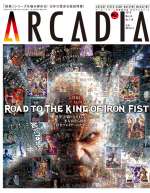 On the heels of all the commotion surrounding the
re-launch of Gamepro and the new EGM coming along in a few months, most
gamers are probably a little bit excited once again about game magazines.
The format seems to have been driven underground in the past few years
with the rise of blogs, gaming sites and even some cable channels.
However, the revival seems to be on track for this year and hopefully some
of these new magazines will deliver a good reading experience. We at the
Laser haven’t been immune to these trends and while we’ve been
waiting, something else has come along to fill the void. The best of these
alternate sources we’ve found lately is
Japan
’s
great
Arcadia
magazine. Devoted to the arcade scene, each issue is filled with the
latest news and information, primarily covering companies like SNK and
Capcom. These are covered extensively along with some other odd and
obscure titles that gives you an interesting exploration of gaming
culture.
Arcadia
’s
superb design and layout makes each issue a joy to look through, even if
you can’t read Japanese. We’ve been buying loads of back issues over
the past few months and while the magazine isn’t as thick or robust as
it used to be back in the early 2000’s, it’s still an incredibly
interesting book to look through. They even have a small section for
classic arcade games, where the PCB’s are shown, plus an extensive
reader-art section. Even the advertising is interesting to look through,
since it gives you a glimpse of what’s to come out in the next few
months.
On the heels of all the commotion surrounding the
re-launch of Gamepro and the new EGM coming along in a few months, most
gamers are probably a little bit excited once again about game magazines.
The format seems to have been driven underground in the past few years
with the rise of blogs, gaming sites and even some cable channels.
However, the revival seems to be on track for this year and hopefully some
of these new magazines will deliver a good reading experience. We at the
Laser haven’t been immune to these trends and while we’ve been
waiting, something else has come along to fill the void. The best of these
alternate sources we’ve found lately is
Japan
’s
great
Arcadia
magazine. Devoted to the arcade scene, each issue is filled with the
latest news and information, primarily covering companies like SNK and
Capcom. These are covered extensively along with some other odd and
obscure titles that gives you an interesting exploration of gaming
culture.
Arcadia
’s
superb design and layout makes each issue a joy to look through, even if
you can’t read Japanese. We’ve been buying loads of back issues over
the past few months and while the magazine isn’t as thick or robust as
it used to be back in the early 2000’s, it’s still an incredibly
interesting book to look through. They even have a small section for
classic arcade games, where the PCB’s are shown, plus an extensive
reader-art section. Even the advertising is interesting to look through,
since it gives you a glimpse of what’s to come out in the next few
months.
One of the coolest, yet frustrating things to hear about are the cool
arcade card games like Lord of Vermillion, which is a cool idea that
probably won’t ever make it west because of the lack of arcades.
There’s also extensive coverage of games like KOF and SFIV, which are
quite popular with gamers, but are marginalized in many
US
magazines, which is a shame, but not surprising. Reading through these
issues at least allows you to see what might have been if western gamers
hadn’t abandoned arcade culture. The only drawback to reading
Arcadia
comes with the prices – recent issues are very expensive with a series
of recent tournament DVD’s making them even more so. Since there’s so
little coverage of the
Japan
scene out there now, getting information direct from the source seems like
the only choice for the serious gamer.
(January 20) Ubisoft's
overnight success
It's been a bit strange
reading high-profile bloggers and industry pundits fall over themselves
trying to explain the unexpected success of Ubisoft's Just Dance on the
Wii platform in December's NPD numbers. No one really predicted it would
hit the top 20, with so many high-profile launches like Modern Warfare 2
and New Super Mario Bros. competing for attention. Just Dance didn't have
the usual amount of hype to go along with it - but it didn't need much of
a sales pitch, a massive ad campaign or coverage from the hardcore press
anyway. There were many factors that worked with it including a huge surge
in holiday Wii sales, the game's accessible track list didn't hurt, with
many mainstream songs and a low retail price didn't hurt either. On the
contrary, our thinking is along the lines that the biggest surprise in the
Just Dance mini-phenomenon is the fact that the game didn't sell better
than it did.
Let's face it, music games
are not a fad and have become about as much a part of the game firmament
as fighting games and FPS titles. The recent decline in music game sales
more than likely represents more a leveling off than a serious fall in
interest levels. Going back over the past few years, with titles like
Guitar Hero and Rock Band, casual gaming's embrace of these titles hasn't
been anything but a huge success. A new category has been created, that
along with the Wii itself, has brought in an entirely new audience for
electronic games. There will be those who want to pit the new gamers
against the hardcore, but this is a false argument. The video game
industry has grown so vast and huge, that it can support a variety of
products aimed at different audiences.
What this results in for
the end user is that an enlarged marketplace means that there's no longer
a zero-sum game. The success of one product doesn't mean failure for
another. Both kinds of titles can happily co-exist and succeed. This is
actually a good thing in the long run, since a more diverse audience means
a more stable industry that can deliver a steady stream of games targeted
to all types of players. While many might find the success of mainstream
titles like Just Dance to be a threat to the hardcore gaming community,
it's really a matter of perception. Remember, music games have played a
big part in gaming's past, and even if you look back further than these
past few years, there were titles like Konami's Dance Dance Revolution
that attracted those outside the gaming hardcore. Hardcore gamers can
choose to get angry and punch at the wind looking at those rows of games
they personally might not be interested in, or they can be glad that
there's more than enough entertainment to go around. The choice is up to
them.
(January
19) Gaming in
Motion
One of the more interesting things that
we're looking at this year is the emergence of motion control on X360 and
PS3. Both consoles seem to be playing catch-up to the Wii in this
department at the current rate. Introducing motion-control systems to
these systems 4 years after Nintendo introduced its new interface seems
like a move to try and grab some of the new audience enamored by the Wii.
Microsoft and Sony are taking very different approaches to the phenomenon,
so it will be interesting to see which one is able to take market share
from the Wii. Sony's approach seems to be taking a little bit from the Wii
and its currently un-named device seems to very much resemble the Wiimote.
Using the existing eyetoy technology seems like a patchwork idea, though
the demos that were seen at E3 didn't really impress us all that much.
There looks like there will be at least some third-party support this
year, but it hasn't generated nearly as much excitement as it could have.
Its odd design and somewhat tepid reception might mean the motion
controller might end up as another attempt that falls short, much as the
little-used and much reviled Sixaxis controls seem to have fallen by the
wayside. With the PS3 already in a distant third-place, it doesn't seem
like the company's strategy of aping the Wii approach will really make
much of a difference.
Obviously, you've probably heard a lot
about Project Natal at this point, but there are still many questions
about this hyped-product. Microsoft is promising something revolutionary
where gamers won't have to use their hands, and a device that reads body
movement. It seems almost like something out of a science fiction movie.
The demos that have been produced to date seem impressive, but whether the
final product can live up to its promise is a huge question that hasn't
been answered. Microsoft also claims massive support for Natal, but
whether developers embrace their vision or merely produce a bunch of
me-too party games is going to determine whether or not the new interface
will take hold. If the company seems like its merely going to copy the Wii
approach, it doesn't seem likely that Project Natal will succeed. Another
key question that's yet to answered is how much the device is going to
cost. Rumors are all over the map in this department and while a low price
would make this an accessible mass-market product, the question is whether
Microsoft will subsidize the hardware, or if the early adopters are going
to pay to be the first on their block to play the device. There's little
doubt that the Project Natal technology is impressive, and it's garnered
plenty of excitement in press over the past year. However, with
Microsoft's history of rushing technology to the market before its ready,
the Xbox 360's bungled launch awash with red ring systems is a prime
example, as is Windows Vista, we're taking a wait and see attitude before
jumping to proclaim it as the next big thing.
In our opinion, it definitely seems like
both consoles are playing catch up with the Wii. While both are promising
to take a jump forward above and beyond what Nintendo is offering, it
remains to be seen whether they'll catch the motion wave, or find
themselves perceived by gamers as trying to mimic Nintendo's runaway
success with desperate half-measures.

